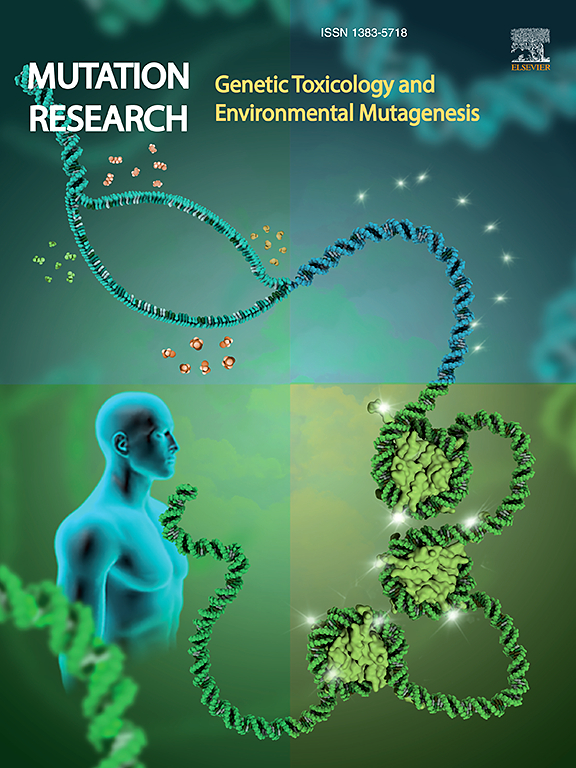Chernobyl as a natural laboratory: Genetic instability, adaptation, and ecological recovery in flora and fauna under chronic radiation
IF 2.5
4区 医学
Q3 BIOTECHNOLOGY & APPLIED MICROBIOLOGY
Mutation research. Genetic toxicology and environmental mutagenesis
Pub Date : 2025-09-19
DOI:10.1016/j.mrgentox.2025.503898
引用次数: 0
Abstract
The Chernobyl nuclear accident of April 1986 remains the most severe nuclear disaster in human history, with long-lasting consequences for ecosystems exposed to chronic ionizing radiation. In the decades since the event, the Chernobyl Exclusion Zone has become an unintended but invaluable natural laboratory for investigating the genetic and ecological effects of persistent radiation exposure. This review synthesizes current knowledge on both immediate and long-term biological consequences observed in plants and animals inhabiting contaminated areas. Initial impacts included acute mortality, reproductive failure, and ecosystem collapse, most notably exemplified by the “Red Forest.” Over subsequent years, studies revealed elevated mutation rates, chromosomal aberrations, genomic instability, and heritable genetic damage across diverse taxa. At the same time, evidence of adaptive responses has emerged, including increased antioxidant defenses, epigenetic modifications, and phenotypic changes such as melanism in amphibians. Flora and fauna within the exclusion zone illustrate the dual narrative of vulnerability to mutagenic stress and resilience through evolutionary adaptation. Comparisons with the Fukushima accident demonstrate convergent biological responses across ecosystems while highlighting the importance of context, such as terrestrial versus marine contamination and remediation strategies. Future research must integrate advanced genomic and epigenomic tools, accurate dosimetry, and long-term monitoring to clarify thresholds for harmful versus adaptive outcomes. Chernobyl thus continues to provide critical insights into radiation biology, ecological recovery, and evolutionary toxicology under conditions of chronic environmental stress.
切尔诺贝利作为一个自然实验室:长期辐射下动植物的遗传不稳定性、适应和生态恢复
1986年4月的切尔诺贝利核事故仍然是人类历史上最严重的核灾难,对暴露于慢性电离辐射的生态系统造成了长期后果。在事故发生后的几十年里,切尔诺贝利禁区无意中成为了一个宝贵的天然实验室,用于研究持续辐射照射的遗传和生态影响。这篇综述综合了目前对居住在污染地区的植物和动物观察到的直接和长期生物学后果的了解。最初的影响包括急性死亡率、繁殖失败和生态系统崩溃,最明显的例子是“红色森林”。在随后的几年里,研究揭示了不同分类群中突变率升高、染色体畸变、基因组不稳定性和遗传性遗传损伤。与此同时,适应性反应的证据已经出现,包括抗氧化防御增强,表观遗传修饰和表型变化,如两栖动物的黑化。禁区内的动植物说明了对诱变压力的脆弱性和通过进化适应的复原力的双重叙述。与福岛事故的比较表明,整个生态系统的生物反应趋同,同时强调了环境的重要性,例如陆地污染与海洋污染以及补救策略。未来的研究必须整合先进的基因组学和表观基因组学工具、精确的剂量学和长期监测,以明确有害和适应性结果的阈值。因此,切尔诺贝利继续为长期环境压力条件下的辐射生物学、生态恢复和进化毒理学提供重要见解。
本文章由计算机程序翻译,如有差异,请以英文原文为准。
求助全文
约1分钟内获得全文
求助全文
来源期刊
CiteScore
3.80
自引率
5.30%
发文量
84
审稿时长
105 days
期刊介绍:
Mutation Research - Genetic Toxicology and Environmental Mutagenesis (MRGTEM) publishes papers advancing knowledge in the field of genetic toxicology. Papers are welcomed in the following areas:
New developments in genotoxicity testing of chemical agents (e.g. improvements in methodology of assay systems and interpretation of results).
Alternatives to and refinement of the use of animals in genotoxicity testing.
Nano-genotoxicology, the study of genotoxicity hazards and risks related to novel man-made nanomaterials.
Studies of epigenetic changes in relation to genotoxic effects.
The use of structure-activity relationships in predicting genotoxic effects.
The isolation and chemical characterization of novel environmental mutagens.
The measurement of genotoxic effects in human populations, when accompanied by quantitative measurements of environmental or occupational exposures.
The application of novel technologies for assessing the hazard and risks associated with genotoxic substances (e.g. OMICS or other high-throughput approaches to genotoxicity testing).
MRGTEM is now accepting submissions for a new section of the journal: Current Topics in Genotoxicity Testing, that will be dedicated to the discussion of current issues relating to design, interpretation and strategic use of genotoxicity tests. This section is envisaged to include discussions relating to the development of new international testing guidelines, but also to wider topics in the field. The evaluation of contrasting or opposing viewpoints is welcomed as long as the presentation is in accordance with the journal''s aims, scope, and policies.

 求助内容:
求助内容: 应助结果提醒方式:
应助结果提醒方式:


